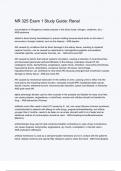NR 325 Exam 1 Study Guide: Renal
accumulation of nitrogenous waste products in the blood (urea, nitrogen, creatinine, etc.) -
ANS-azotemia
added to blood during hemodialysis to prevent clotting because blood tends to clot when it
encounters a foreign material, such as the dialyzer - ANS-heparin
AKI caused by conditions that do direct damage to the kidney tissue, resulting in impaired
nephron function. can be caused by nephrotoxins, hemoglobin/myoglobin accumulation,
interstitial nephritis, acute tubular necrosis, etc. - ANS-intra-renal AKI
AKI caused by factors that reduce systemic circulation, causing a reduction in renal blood flow
and decreased glomerular perfusion/filtration of the kidneys. examples include HF, MI,
cardiogenic shock, dysrhythmias, anaphylaxis, septic shock, embolism, renal artery thrombosis,
hypovolemia (burns, dehydration, excessive diuresis, GI losses, hemorrhage,
hypoalbuminema). can contribute to intra-renal AKI because prolonged lack of perfusion causes
damage to kidney tissue - ANS-pre-renal AKI
AKI caused by mechanical obstruction in the outflow of urine, causing urine to reflux into the
renal pelvis and impairing kidney function. examples include BPH, bladder/prostate cancer,
stones, trauma, extrarenal tumors, neuromuscular disorders, spinal cord disease, or strictures -
ANS-post-renal AKI
alpha adrenergic blocker used to relax muscles in the prostate and bladder for easy urine flow.
can cause priapism, angioedema, or rash/hives. women and children should not handle this
drug. - ANS-tamsulosin (Flomax)
antibiotic most often used to treat UTI caused by E. coli. can cause Stevens-Johnson syndrome.
contraindicated to patients with allergy to sulfa drugs, pregnancy/breastfeeding, and infants
younger than 2 months. needs to be taken on an empty stomach with 8 oz of water and an
additional method of contraception should be used. - ANS-trimethoprim/sulfamethoxazole
(Bactrim)
anticholinergic drug used to treat overactive bladder contractions in urge urinary incontinence.
can cause dyspnea, tachycardia, angioedema, dry mouth, constipation, or blurred vision -
ANS-oxybutynin (Ditropan)
artificial membrane is used as a semipermeable membrane and is in contact with the patient's
blood. dialysis machine and special filter (dialyzer) used to clean the blood - ANS-hemodialysis
,best method for confirming intra-renal causes of AKI, may be needed to provide a definitive
diagnosis of CKD - ANS-renal biopsy
best treatment option available for patients with ESRD, reverses many of the pathologic
changes associated with kidney disease, eliminates dependence on dialysis and need for
dietary/lifestyle restrictions - ANS-kidney transplant
beta-3-adrenergic agonist that improves bladder storage capacity by relaxing bladder muscle
during filling, can be used to help manage urege incontinence - ANS-mirabegron
calcimemetic drug used to control secondary hyperparathyroidism in patients with CKD, mimics
calcium and increases sensitivity of calcium receptors in parathyroid glands - ANS-cinacalcet
(Sensipar)
can be an effective treatment for stress incontinence in women - ANS-sling surgery
can be used to treat urinary incontinence due to detrusor overactivity. is injected into the
bladder, resulting in bladder relaxation, increased storage capacity, and decreased incontinence
- ANS-botox
cause of intra-renal AKI, block tubules and cause renal vasoconstriction, which restricts blood
flow to the kidneys. can occur due to hemolytic blood transfusion reaction or severe crush injury
- ANS-hemoglobin and myoglobin
clean-catch urine sample preferred for this diagnostic test for UTI. needed if there is persistent
bacteriuria, recurrent UTIs, or complication UTI/CAUTI - ANS-urine culture
combination of stress and urge incontinence - ANS-mixed incontinence
common after lithotripsy procedures to remove kidney stones for the first few times a patient
voids - ANS-hematuria
complication of CKD that occurs due to low calcium levels - ANS-hyperparathyroidism
complication of peritoneal dialysis, inflammation of the peritoneum (membrane lining the
abdominal cavity and surrounding the organs within it) caused by contact contamination, exit
site/tunnel infection, improper technique during exchanges, etc. repeated infections can cause
adhesions in the peritoneum, interfering with the membrane's ability to act as a dialyzing surface
- ANS-peritonitis
complication of peritoneal dialysis; the peritoneal membrane is permeable to plasma proteins,
amino acids, and polypeptides - ANS-protein loss
, complications of peritoneal dialysis that occur from repeated upward displacement of the
diaphragm. examples include atelectasis, pneumonia, bronchitis, etc. - ANS-pulmonary
complications
diagnostic test for UTI that involves a urine sample to analyze WBCs, RBCs, leukocyte
esterase, or bacteria in the urine. - ANS-dipstick urinalysis
diagnostic test used for chronic pyelonephritis, shows loss of functioning nephrons,
inflammatory cells in the parenchyma, and kidney fibrosis. can progress to ESRD - ANS-renal
biopsy
drug given to patients with uric acid stones. should be given after meals with plenty of water.
patients should discontinue at first sign of skin rash and report unusual bruising/bleeding, flank
pain, fever, chills, or skin rash - ANS-allopurinol
drug used to enhance bladder contractions, can help relieve overflow incontinence -
ANS-bethanechol (urecholine)
drug used to treat hyperkalemia, raises threshold at which dysrhythmias occur and temporarily
stabilizes the myocardium. used in advanced cardiac toxicity - ANS-calcium gluconate IV
drug used to treat uncomplicated UTI, should avoid use if patient's creatinine clearance is less
than 30 mL/min. can cause GI discomfort. should be avoided during pregnancy. can turn urine
rust, yellow-brown color and can stain teeth. report bruising/epistaxis - ANS-nitrofurantoin
drugs that accumulate in the body of patients with kidney dysfunction because of inability to be
excreted by kidneys. should be avoided. - ANS-magnesium/aluminum antacids
drugs that can be used for urge incontinence by reducing overactive bladder contractions -
ANS-tricyclic antidepressants (amitryptiline, imipramine)
drugs that can be used to manage urge incontinence, reduce smooth muscle contraction
strength and may reduce burning pain of interstitial cystitis - ANS-calcium channel blockers
(diltiazem, nifedipine, verapamil)
drugs that can contribute to AKI and progression of CKD and should be avoided in patients with
renal dysfunction - ANS-NSAIDs
drugs that contain phenylephrine/pseudoephedrine that cause vasoconstriction and can
increase BP. should warn patients with kidney disease to avoid. -
ANS-decongestants/antihistamines




